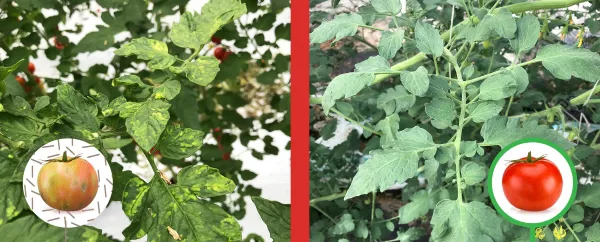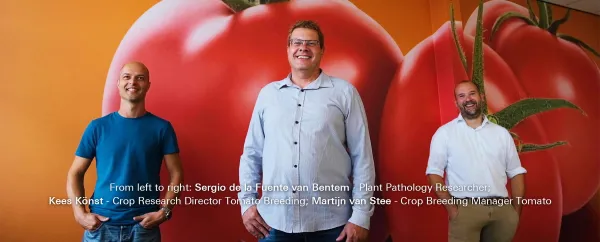It’s a small, green, hairy tomato growing on a wild tomato plant. To be honest, it doesn’t look too impressive and you might easily overlook it. Yet still, this is the tomato plant that could change the whole tomato world and save the industry. In this tomato, researchers of Enza Zaden discovered a gene with high levels of resistance against ToBRFV, the virus that has threatened the global value chain of tomatoes. Yesterday, they shared more information on the resistance that will be introgressed in many more tomato varieties in the upcoming period.

Difference between infected and protected crop
It has been six years since a new virus popped up in the international tomato industry. ToBRFV was first discovered in Israel and spread rapidly into the Middle East. By now, growers all over the world have to deal with the effects of the Tomato Brown Rugose Fruit Virus. If it’s not by infection, resulting in lower yields, damaged fruits, complete loss of yields, soils that have been contaminated and became useless for tomato growing, than it is by the extensive hygiene measures and strict import rules put into place to protect countries and companies from infection.
Tobamo-virus
Shortly after the discovery of the virus it was also found out that ToBRFV is a tobamo-virus, meaning that it’s very stable and can survive for a long time. “Many years even, in the soil,” Sergio de la Fuente van Bentem, plant pathology researcher at Enza Zaden, says, adding that also the vial particles of the virus are almost impossible to kill. “Only the best disinfectants can, but the main thing is protection – getting rid of all infected parts of your crop and destroy it thoroughly, since the virus can spread via seeds, which is how we presumed it has spread rapidly through the entire globe, but also via irrigation water, pollinators, and mechanically, with workers cutting or pruning and spreading the virus from plant to plant.” Then there’s the spread via the fruits itself and via other crops such as tobacco – a plant that also is affected by the virus.
Other Tobamo-viruses have been threatening the industry in the past as well, yet thanks to Tm-2 and Tm-2² resistances, the industry has been secured of a virus-free harvest for almost 55 years – that is until ToBRFV kicked in and broke these resistances.
Wild tomato plant
Now the researches with Enza Zaden are presenting a gene that provides high resistance to the worldwide rapidly spreading virus. Following the discovery of the virus back in 2014, the team of the breeding company quickly acted and started doing research in order to find a solution. Following extensive tests in the Enza Zaden gene bank resulted in finding one number that contained some resistant plants and further testing resulted in the finding of a wild tomato plant producing small, green, hairy fruits.
“Finding the resistance is one thing, but breeding it in and learning more about it makes our work complicated and also time-consuming," Kees Konst, Crop Research Director Tomato says. Fortunately, they were also lucky, also research into the DNA of the genes showed that it was a single gene responsible for this resistance and this also turned out to be a fully dominant gene, meaning that it only needs to be in one of the two parental lines to ensure a resistance F1 hybrid. The finding of a molecular marker increased the breeding speed and the researchers have been able to introgress it into cultivated plants – something that took many years since they had to cross it with other tomato varieties while keeping the gene.
“It’s like finding a needle in a haystack, followed by hard work to get it in our lines”, Kees summarizes – but the results could be world-changing since the many experiments show that the resistance is so strong that the plants are not only free of symptoms, but also free of the virus itself, as is shown by a PCR method. Even field tests conducted in Jordan and even manual infection with the virus did not result in infected plants. “Meaning that with HR resistance, we can eradicate the virus from tomato crops.”
HR instead of IR
Before this specific gene turned up, the team found also genes with intermediate levels of resistance, that could result in a variety with an IR against ToBRFV. “With intermediate resistance, the virus can maintain in the world and will continue to infect crops, both professional as well as the crops of small growers working with heirloom varieties that are often sensible to viruses. An intermediate resistance will delay the symptoms, but will not stop the spread. Only with the right HR resistance, we can eradicate the virus and forget about all the rulings we have been dealing with on the seeds and the risks on cross border controls and blockades.
"An HR resistance is the only way to get rid of this virus,” Prudencio Olivares says – something that as a sales manager he’s very aware of. “We’ve seen how ToBRFV is a serious threat for the whole tomato chain and even believe that the list of countries where ToBRFV is found, is too short and that the real distribution is unknown, since the molecular detection techniques needed to identify the virus aren’t implemented everywhere, making some countries unable to identify the virus.”

Tomato Breeding Team picture
Timeline
Now that the gene is discovered, the first question to ask is when. When can growers expect varieties that are HR to ToBRFV grown in their greenhouses? An exact date cannot be given, the team with Enza Zaden shares, since it’s still a time-consuming process. But the first HR hybrids are coming in “We’ll start planning research trials with small amounts of plants and try to speed up getting them to the market but the varieties we bring, have to fulfill the market needs as well.” Following an analysis of the threats, they’re focusing on various key markets to help first: the Middle East, where it all started, the European market, because there’s much cross-border trade, and the Mexican market, since the US is also at stake there.
“But we believe the virus will spread, so for sure we won’t forget about other markets,” the researchers say, adding that the resistance that they found seems resistance to different ToBRFV isolates found all over the world and also explaining that they will come with a broad range of materials for different tomato types. “Small sized tomatoes, mini plums, beef tomatoes, plum tomatoes,” Kees sums up.
In addition and thanks to the collaboration of breeding companies via the international license platform, other breeding parties could also have access to the resistance.

